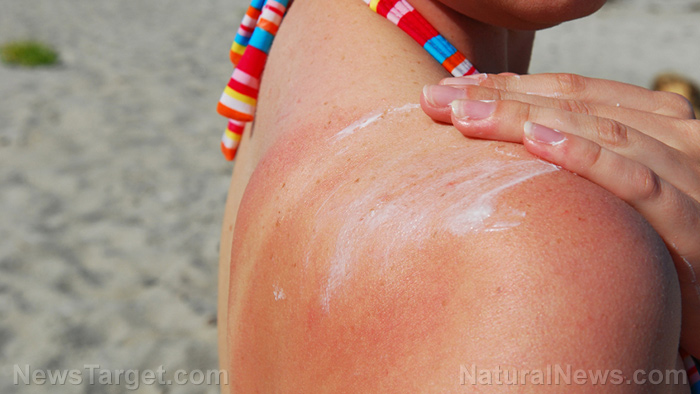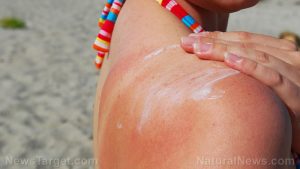
Dermatitis – causes, side effects and treatments at NaturalPedia.com
Tuesday, March 06, 2018 by Ralph Flores
http://www.naturalpedia.com/dermatitis-causes-side-effects-and-treatments-at-naturalpedia-com.html

Dermatitis is a collective term for a variety of inflammatory skin conditions. The etiology of each disease is different; however, these are all characterized by conditions such as erythema (redness of the skin), scaling, the formation of vesicles (fluid-filled sacs in the skin), and itching. In severe cases, lichenification – a condition where the skin is thick and leathery – occurs as a complication of chronic skin inflammation.
Some common types of dermatitis include the following.
- Atopic dermatitis (AD) — A condition characterized by severe itching of the skin, atopic dermatitis is a chronic inflammatory skin disease commonly associated with increased levels of immunoglobulin E (IgE). People can get the condition early in life, and it has a chronic and relapsing course.
- Allergic contact dermatitis — The condition is characterized to be a “delayed type of induced sensitivity” caused by an allergen coming to direct contact with the skin.
- Irritant contact dermatitis (ICD) — This occurs the skin becomes inflamed upon contact with a chemical, biologic, or physical irritant. To treat both allergic and irritant contact dermatitis, identifying the offending agent and avoiding future contact is important.
- Stasis dermatitis — A common inflammatory skin disease, stasis dermatitis occurs in the trunk area and is an indicator of chronic venous insufficiency, that is, the condition that the blood from the lower extremities is not flowing back into the heart.
- Dyshidrotic eczema — A type of eczema that causes an itchy vesicular eruption on the fingers, palms, and soles, dyshidrotic eczema affects teenagers and adults. Its recurrence may either be acute, recurrent, or chronic, and the severity can be anywhere from mild to even debilitating.
- Seborrheic dermatitis — A condition that can be seen in skin areas with sebaceous glands, seborrheic dermatitis occurs across the face, nose, and the inside of the ears. Its etiology is unclear, but scientists believe that a yeast called Malassezia can be a potential cause.
- Neurodermatitis — The condition is triggered when the subcutaneous nerve endings are irritated, prompting an overwhelming urge to scratch the affected area repeatedly.
- Perioral dermatitis — This is a chronic case of dermatitis common in women and children. While its etiology is unknown, using topical steroids for an extended period has been identified as one of the causes of the condition.
- Dermatitis herpetiformis — An autoimmune blistering disorder that is linked to gluten-sensitive enteropathy, dermatitis herpetiformis – also referred to as the Duhring disease – typically forms lesions on the surfaces of the elbows, knees, buttocks, and the back.

Known risk factors and symptoms of dermatitis
While different forms of dermatitis have their own distinct signs and symptoms, the usual symptoms include:
- Itching
- Painful skin sores (ulcers)
- Reddening of the skin
- Thickening of the skin (lichenification)
- Swelling
- Discoloration
- Appearance of marks
- Crusting
- Scaling
- Creasing
- Blisters (vesicles)
Some forms of dermatitis have unknown etiologies, but typical causes include exposure of the skin to allergens and irritants, as well as oily skin or hair and even stress.
Body systems affected by dermatitis
Dermatitis primarily affects the skin.
Food items or nutrients that may prevent or relieve dermatitis
While diet is an essential factor in reducing the incidence of dermatitis, identifying the specific food or environmental allergen and avoiding it will significantly improve a person’s quality of life.
Common allergens include dairy, soy, citrus, peanuts, wheat (and sometimes all gluten-containing grains), fish, eggs, corn, and tomatoes. Eating fewer saturated fats, refined goods, and sugar is also beneficial, as these foods play a factor in the body’s inflammatory responses.
Moreover, a diet that consists of an added intake of fresh vegetables, whole grains, and essential fatty acids (cold-water fish, nuts, and seeds) can also aid the body.
Additionally, here are some recommended food items to help deal with dermatitis:
- Fish oil — A study has found that people who took fish oil had significantly reduced the symptoms of eczema. However, a person taking anticoagulants should consult a medical professional before using it.
- Probiotics — These boost the immune system and help control breakouts, especially in children.
- Evening primrose oil — It aids in reducing itching caused by dermatitis.
- Borage oil — Similar to evening primrose oil, the essential fatty acid GLA found in borage oil reduces inflammation and symptoms related to eczema.
- Vitamin C — An antihistamine, vitamin C found in rose hips and palmitate are free from citrus and can reduce eczema symptoms.
- Flavonoids — Found in dark berries and some plants, flavonoids have anti-inflammatory properties and can help reduce allergic reactions.
- Vitamin D — A study has shown that not having enough vitamin D increases the risk of food allergies and dermatitis.
Treatment and management options for dermatitis
There are various ways to treat dermatitis; however, these depend on the underlying cause and the severity of the condition. Applying corticosteroid creams, calcineurin inhibitors, and phototherapy are some treatment plans available for patients with the condition.
Where to learn more
- Tattoos may lead to HEAT STROKE by impairing your skin’s natural sweat production
- Guava Leaf Tea Fights Cancer, Lowers Cholesterol and Treats Diabetes
- Your water could be causing your eczema: Hard water found to damage the protective barrier on skin
- Researchers reveal allergies may be linked to eczema
- Hypnotherapy as a treatment for Atopic Dermatitis in Adults and Children
Summary
Dermatitis is a collective term for a variety of inflammatory skin conditions. Some forms of dermatitis have unknown etiologies, but typical causes include exposure of the skin to allergens and irritants, as well as oily skin or hair and even stress.
Dermatitis primarily affects the skin. While diet is an important factor in reducing its incidence, identifying the specific food or environmental allergen and avoiding it will greatly improve a person’s quality of life. There are various ways to treat the condition; however, these depend on the underlying cause and the severity of the condition.
Sources include:
Tagged Under: Tags: dermatitis





